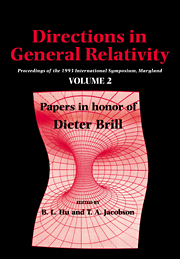 Directions in General Relativity
Directions in General Relativity Published online by Cambridge University Press: 06 January 2010
Abstract
We present the (1+1)-dimensional method for studying general relativity of 4-dimensions. We first discuss the general formalism, and subsequently draw attention to the algebraically special class of space-times, following the Petrov classification. It is shown that this class of space-times can be described by the (1+1)-dimensional Yang-Mills action interacting with matter fields, with the spacial diffeomorphisms of the 2-surface as the gauge symmetry. The (Hamiltonian) constraint appears polynomial in part, whereas the non-polynomial part is a non-linear sigma model type in (1+1)-dimensions. It is also shown that the representations of w∞-gravity appear naturally as special cases of this description, and we discuss briefly the w∞-geometry in term of the fibre bundle.
Introduction
For past years many 2-dimensional field theories have been intensively studied as laboratories for many theoretical issues, due to great mathematical simplicities that often exist in 2-dimensional systems. Recently these 2-dimensional field theories have received considerable attention, for different reasons, in connection with general relativistic systems of 4-dimensions, such as self-dual spaces [1] and the black-hole space-times [2, 3]. These 2-dimensional formulations of self-dual spaces and blackhole space-times of allow, in principle, many 2-dimensional field theoretic methods developed in the past relevant for the description of the physics of 4-dimensions.
To save this book to your Kindle, first ensure [email protected] is added to your Approved Personal Document E-mail List under your Personal Document Settings on the Manage Your Content and Devices page of your Amazon account. Then enter the ‘name’ part of your Kindle email address below. Find out more about saving to your Kindle.
Note you can select to save to either the @free.kindle.com or @kindle.com variations. ‘@free.kindle.com’ emails are free but can only be saved to your device when it is connected to wi-fi. ‘@kindle.com’ emails can be delivered even when you are not connected to wi-fi, but note that service fees apply.
Find out more about the Kindle Personal Document Service.
To save content items to your account, please confirm that you agree to abide by our usage policies. If this is the first time you use this feature, you will be asked to authorise Cambridge Core to connect with your account. Find out more about saving content to Dropbox.
To save content items to your account, please confirm that you agree to abide by our usage policies. If this is the first time you use this feature, you will be asked to authorise Cambridge Core to connect with your account. Find out more about saving content to Google Drive.